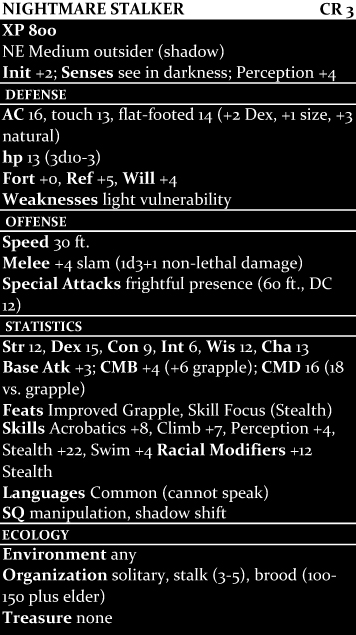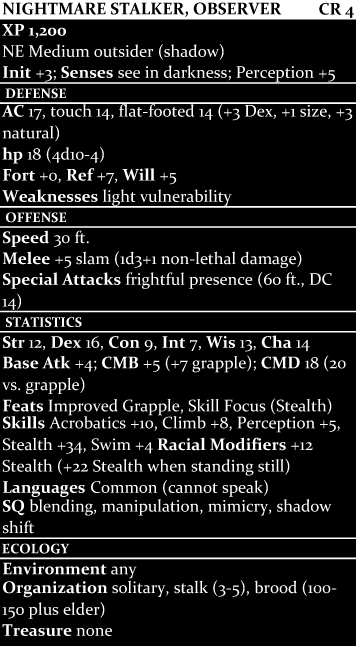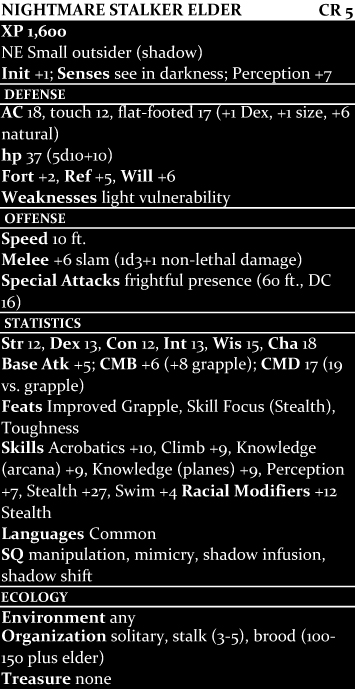Nightmare Stalkers
Editor’s Note: This article was originally intended for next week’s From the Workshop, but due to some clerical errors, we wound up with two articles for Darkness Week. As such, we’ve decided to start Darkness Week a little early, with this article about a fantastic darkness dweller known as the nightmare stalker.
Greetings traveler, and welcome to this week’s From the Workshop. This is Darkness Week, and all kinds of horrors are awakening from the shadows to drag you and your players to a world of gloom and despair. About a decade ago, I watched a movie, far from being a blockbuster, which would greatly inspire me in the conception of horror. That movie, named They, featured a creature that would become a staple in many of my horror adventures, to the point of my players associating the sound of my fingers ticking on the table with the disturbing presence of the nightmare stalkers.
Nightmare stalkers are outsiders, natives to the Plane of Shadow. Physically, they resemble a human, having two legs, two arms and a head, but this is not always evident, since their elongated limbs permit them great flexibility that they exploit by assuming bizarre poses to better aid them at what they excel: hiding. Typically a nightmare stalker stands with its belly on the ground, moving much like a quadruped spider. Their gaunt bodies bear dried grey-black skin, resembling rock covered in dust. The head of a nightmare stalker strongly resembles a skull, being mostly featureless, with empty eye sockets reflecting the darkness of its native plane.
Most of the time nightmare stalkers reside on the Plane of Shadow. They are gathered in broods, each one lead by a single elder: a nightmare stalker that has undergone a vile transformation. A single brood typically has 100-150 members. On their home plane, nightmare stalkers are generally passive. They tend to remain hidden and immobile, unless threatened. Other creatures of the Plane of Shadow ignore nightmare stalkers, their function being an integral part of the plane’s ecology: abducting humans from the Material Plane. Indeed, although nightmare stalkers do little more than terrorize their abductees, powerful undead find the insertion of fresh meat in their home plane… practical, to say the least.
Each nightmare stalker brood varies slightly from the others, but essentially they all function similarly. Contact between broods is non-existent and the material plane is divided in hunting grounds, each one harvested by a single brood.
Every twenty or so years, nightmare stalkers become particularly active. They enter the Material Plane, harvesting humans they had previously marked, and marking new victims for the future. This is called the “culling.” The exact order of actions performed each time is the following:
As soon as the elder instinctually realizes that the time is right, it sends out one stalk for each marked victim still living. A stalk is formed by 3-5 nightmare stalkers. They will track down the intended victim, careful to remain hidden. Using their frightful aura, they will haunt the victim for days, until they find the right moment to strike. Typically this involves the victim being alone, in darkness. At first, a single nightmare stalker will attempt to subdue the victim using non-lethal damage, force it towards the darkest spot in the surrounding environment, and shift back to the Plane of Shadow. If the first attempt fails, subsequent attempts will involve more members of the stalk. Nightmare stalkers are very patient creatures and they will repeatedly attempt to harvest a victim, never willingly injuring it, for months.
Being continually subject to the frightful aura of its stalkers, a victim will eventually suffer a mental collapse. If it is nearing the point of suicide, or it becomes evident that the stalk is not able to accomplish the task, then the elder will send additional stalks to assist. Sometimes an entire brood is focused on a single victim.
A marked victim will never find safe haven. The stalk may go on for years, and the entire brood will not rest until all victims are either harvested, or dead. Elimination of individual members of the brood will not stop future attempts. Instead, there are three methods that would release a victim:
Travelling to the Plane of Shadow, locating the elder of the offending brood, and eliminating him, will effectively put the brood in disarray. The culling will be halted, and the brood will disperse in the Plane of Shadow until a member manages to achieve elder status. At this point, it will gather the brood again, and perform a new culling, marking new victims. Old targets will remain marked only if they still bear the beacon. The process of reanimating a brood may take anywhere from ten to forty years.
Removing the beacon from a child, as soon as it is planted, will effectively erase the victim from the list of marked targets. This must occur within 1d6 days after the beacon has been planted, otherwise removal of the beacon will not erase the marking.
A sufficiently powerful devil (one with at least 12 HD and at least 12 ranks in Knowledge (the planes)) can be beckoned (via spells like planar binding or planar ally) on behalf of an intended or captured victim and release the subject. This usually entails a direct exchange with a fresh victim: a child.
In rare occasions, a stalk does not find the opportunity to strike at all. Sometimes this occurs if the victim is aware of the situation and remains under constant magical surveillance. If it becomes evident that the numbers of nightmare stalkers will not improve the chances of success at all, then the stalk is momentarily abandoned, and a single member remains behind to observe the victim and call the entire brood if an opportunity is presented. A member residing for many months in the Material Plane eventually becomes accustomed to it, and even if the stalk eventually succeeds, it remains there. Such a nightmare stalker becomes an observer, acquiring a number of powers that better allow it to remain hidden in the world of mortals, while prospecting potential victims for future marking.
When the majority of the stalks are nearing completion, the elder will indicate the new victims that will be marked. The marking functions much like a stalk, but the task is arguably easier. Typically, a single nightmare stalker is sent to abduct a human child, aged 5 to 10. Then the elder will plant a beacon on the child, and its abductor will return it to its home. This typically takes two hours to accomplish. Generally, the elder will choose victims that will be easy to mark, avoiding a potential stall at this phase. During a single culling, the elder will indicate 1d12+12 victims for marking. From these, up to half will not be returned. Instead, they will participate in the last phase of the culling.
Once the culling is almost complete (meaning that all victims are either harvested, dead or observed, and the indicated targets have been marked), then the last phase begins, in which the brood renews its members. First of all, if the brood suffered any casualties, the elder will turn a number of the abducted children to nightmare stalkers via the shadow infusion ability. Typically, this includes increasing the total population of the brood, but rarely more than by 1 or 2. Then, as the rest of the brood enters slumber until the next culling, the elder may decide that it’s the time to abandon the Plane of Shadow, and assume its rightful place among the devils of the lower planes. This typically happens after 10 or so cullings. At that point, the elder appoints a nightmare stalker to enter the Negative Energy Plane. This appointed nightmare stalker will remain there for a few years, undergoing a terrible transformation until it assumes the form of the elder. Alternatively, if the elder perishes, and the brood falls in disarray, a nightmare stalker may eventually discover the path to the Negative Energy Plane without any assistance.
This transformation that takes place on the Negative Energy Plane will greatly elevate the mental capacity of the nightmare stalker, awakening the knowledge required to indicate targets for marking, the crafting of beacons, the transformation of children to nightmare stalkers and the process of appointing a new elder. Such a transformation leaves the elder crippled, however. It loses both legs, effectively being forced to move by dragging its body on the ground.
The beacons are jet-black bone spikes, the size of an index finger, and are crafted from the spinal cord of a nightmare stalker. Only an elder knows how to perform the ritual to create them, which consumes one nightmare stalker, and produces 2d6 beacons. During the marking, a beacon is inserted into the body of the victim, leaving a prick. The actual marking of the victim takes place 1d6 days after the beacon is planted, and from that point, removing the beacon does not erase the marking. As long as the beacon is inside, the prick cannot be cured, and although only slightly irritating, it will bleed slightly during a culling. A Heal check (DC 10) can remove the beacon. If the roll fails, the beacon is removed nonetheless, though the subject takes 1d6 points of damage. If the beacon is removed before the victim is actually marked, then the victim is safe. Essentially, this is the only way to avoid the culling. A DC 25 Knowledge (planes) check will reveal the nature of the beacon and some basic information about the nightmare stalkers, while a DC 20 Knowledge (arcana) check will reveal that the removal of the beacon will not necessarily save a marked victim. A beacon can be used an infinite number of times, and someone can intentionally mark himself. Nightmare stalkers usually reclaim the beacons once the victims are abducted or dead.
Abductees are left to roam in the Plane of Shadows, and the nightmare stalkers do nothing to prevent them from escaping. Typically other creatures, usually undead, claim the victims for themselves. Generally, although far from being mindless, nightmare stalkers function quite mechanically and persistently, leading to the assumption that their initial conception is related to a higher power trying to circumvent the typical methodology of harvesting souls. The fact that nightmare stalkers are essentially a race of hideously deformed human children, mercilessly stalking their victims without ever pausing, certainly lends some credibility to the assumption that such creatures are not natural creations.
Frightful Presence (Ex): The mere presence of a nightmare stalker, even without being seen, awakens a deep-seated fear of darkness that all humans possess. When a marked victim is within 60 feet from a nightmare stalker, it must succeed on a Will save or become shaken for as long as they remain within 60 feet of a nightmare stalker, plus an additional 3d6 rounds. This ability functions whether the creature can see the nightmare stalker or not, though if they can, the DC is increased by +3. Additionally, if the marked creature is within 60 feet of 5 or more nightmare stalkers, the DC increases by an additional +2 (though only one Will save is necessary, regardless of how many nightmare stalkers are present). A victim that succeeds on the saving throw is immune to that particular nightmare stalker’s frightful presence for 24 hours. Finally, the first time each day that a marked creature fails its saving throw to resist a nightmare stalker’s frightful presence, it must succeed on a secondary Will save (with the same DC) or suffer 1d3 points of Wisdom damage. This is a mind-affecting fear effect. The save DC is Charisma-based.
Light Vulnerability (Ex): If a nightmare stalker is in an area of normal or brighter light, it becomes staggered. At the end of the third round of light exposure, it dies immediately and its body turns to dust. For this reason, most nightmare stalkers use their shadow shift ability as soon as they encounter light.
Manipulation (Sp): Nightmare stalkers have the capacity to alter reality in a limited way. As a free action, nightmare stalkers can cast prestidigitation as a spell-like ability at will. Usually, nightmare stalkers use this ability to extinguish sources of light and lure victims by making slight noises.
See in Darkness (Ex): All nightmare stalkers can see perfectly in the dark, even magical darkness, as though it were normal light conditions.
Shadow Shift (Sp): As a move action, a nightmare stalker can travel from the Material Plane to the Plane of Shadows, or back again. This functions as the spell plane shift, except that the nightmare stalker can travel only to those two planes, and can take only itself, its gear, and up to one other creature, which must be either willing or unconscious.Finally, when a nightmare stalker uses this ability to travel to the Material Plane, it always appears in an area of dim light or darkness within 1d12 miles of its intended victim.
Blending (Su): Observers receive a +10 racial bonus to Stealth as long as they remain still.
Mimicry (Ex): Observers have the capacity to imitate any human voice they have heard with perfect accuracy. Although they can barely understand Common, it is good enough to imitate a mother’s calling or a cry for help, etc.
Shadow Infusion (Su): An elder nightmare stalker can weave the essence of the Plane of Shadow into a subdued victim, transforming it into a nightmare stalker. A Will Save (DC 15) will negate the effect, and render the target immune to this ability forever, but more often than not, the target is unconscious. The process requires 6 hours to take effect, and once successfully completed, the victim will transform to a nightmare stalker within 1d3 days, permanently. Remove disease, or more powerful restorative magic, can reverse the effect if performed before the transformation is complete. After that, a wish or miracle spell is required to restore the creature to its original form.
Given the natural capacity of nightmare stalkers to remain unseen, and their endless patience, very little is known about them in the mortal world. Relatively more is known about the beacons, and those few that possess such knowledge can use it offensively to mark a victim. Theoretically, it could be possible even to create a beacon, but this would require extensive labor to acquire a living nightmare stalker, prevent its escape, and manage to acquire knowledge of the proper ritual.
That is all for today, kind traveler. Whether your players are investigating unexplained abductions, or one of them realizes that his childhood fears are somewhat more substantial than he or she came to believe, nightmare stalkers present a fine opportunity to add a touch of horror on any adventure and remove that sense of safety overconfident characters display in familiar grounds. Watching the movie that inspired this article may help with getting a feeling of the creature’s nature from the perspective of the victims. Although the article assumes human victims only, it’s easy to adjust the rules to include any player race. Farewell on your journey kind traveler, and do not forget to come back for more.





